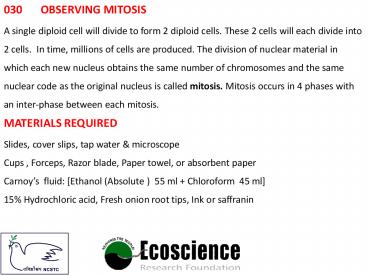030 OBSERVING MITOSIS - PowerPoint PPT Presentation
1 / 4
Title:
030 OBSERVING MITOSIS
Description:
A single diploid cell will divide to form 2 diploid cells. These 2 cells will each divide into 2 cells. In time, millions of cells are produced. The division of nuclear material in which each new nucleus obtains the same number of chromosomes and the same nuclear code as the original nucleus is called mitosis. Mitosis occurs in 4 phases with an inter-phase between each mitosis. – PowerPoint PPT presentation
Number of Views:475
Title: 030 OBSERVING MITOSIS
1
030 OBSERVING MITOSIS
A single diploid cell will divide to form 2
diploid cells. These 2 cells will each divide
into 2 cells. In time, millions of cells are
produced. The division of nuclear material in
which each new nucleus obtains the same number of
chromosomes and the same nuclear code as the
original nucleus is called mitosis. Mitosis
occurs in 4 phases with an inter-phase between
each mitosis.
MATERIALS REQUIRED
Slides, cover slips, tap water microscope Cups
, Forceps, Razor blade, Paper towel, or absorbent
paper Carnoys fluid Ethanol (Absolute ) 55
ml Chloroform 45 ml 15 Hydrochloric acid,
Fresh onion root tips, Ink or saffranin
2
In one cup pour 15 HCl into it to cover the
bottom, and in other cup pour enough Carnoys
fluid in it to cover the bottom. Use forceps to
transfer an onion root tip into the HCl. After 4
minutes, transfer the root to Carnoys fluid and
leave it for 20 minutes. Now place the root on a
slide and with a blade cut off one to two mm of
the root tip for the preparation. Cover this root
tip with a few drops of ink or Saffranin for 2
minutes, blot away the excess stain. Be careful
not to touch the root tip.
Cover the root tip with one to two drops of water
put a cover slip over the root, put a paper towel
or other absorbent paper and with your thumb
firmly press on the cover slip.
cover slip
root tip
glass slide
3
Observe your preparation under the low power of a
microscope. Search the slide to find cells in
various stages of cell division, once you have
located cells in division, change to high power
try to observe several stages of division
The majority of the cells will be in interphase.
Of the cells undergoing mitosis, the majority
will be in prophase, while very few will be in
metaphase, anaphase, and telophase
4
(No Transcript)































